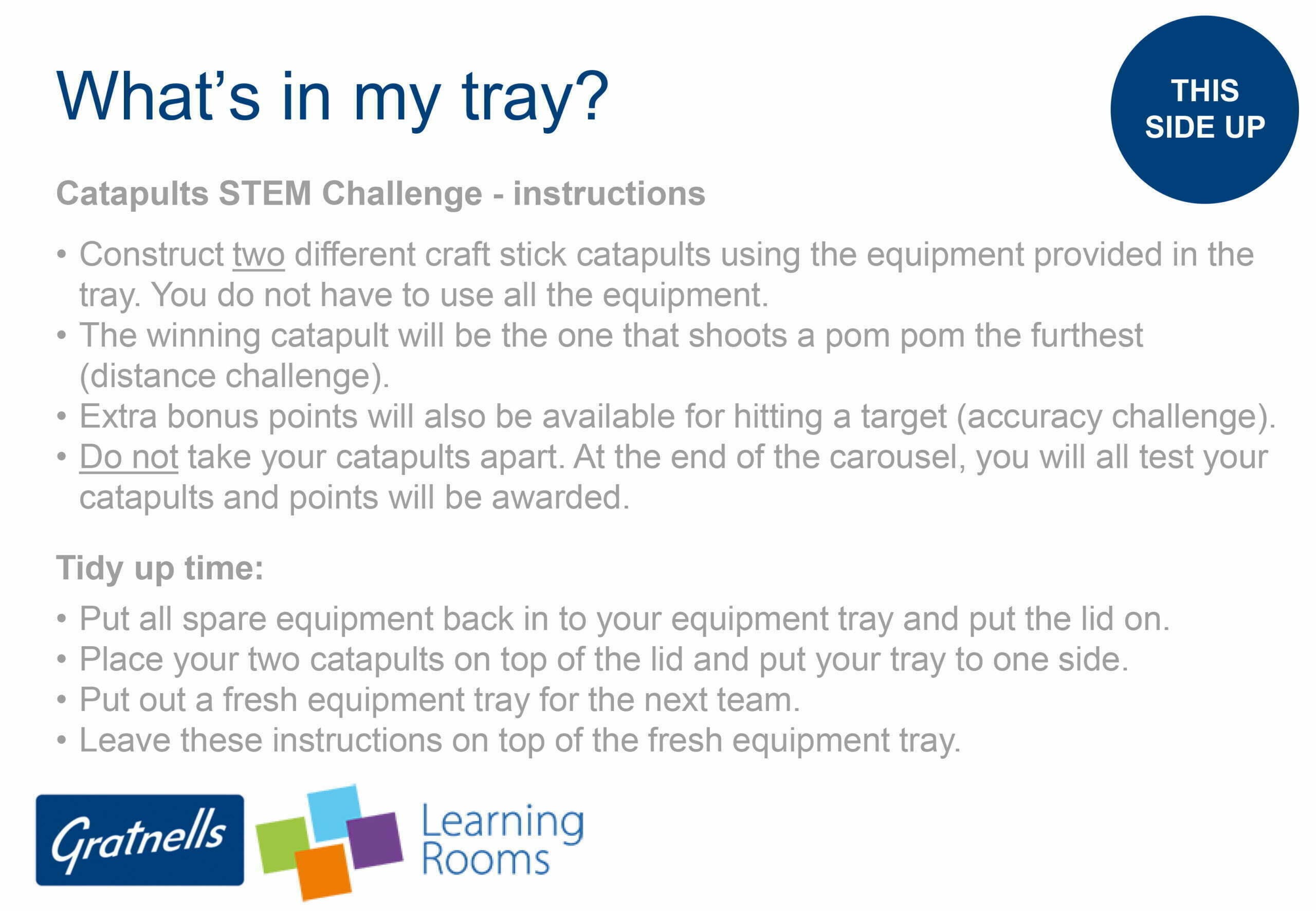Catapults STEM challenge
This activity was created as part of a Gratnells What’s in my tray? CPD workshop for primary and secondary science teachers and technicians to support practical work and delivery of the curriculum. It can be carried out as a stand-alone activity for students or combined with other activities from the session to form a STEM carousel. If you would like to find out more about running this activity as part of a carousel, take a look at the CPD Workshops section of the Gratnells Learning Room website where you will find further details and example carousels.
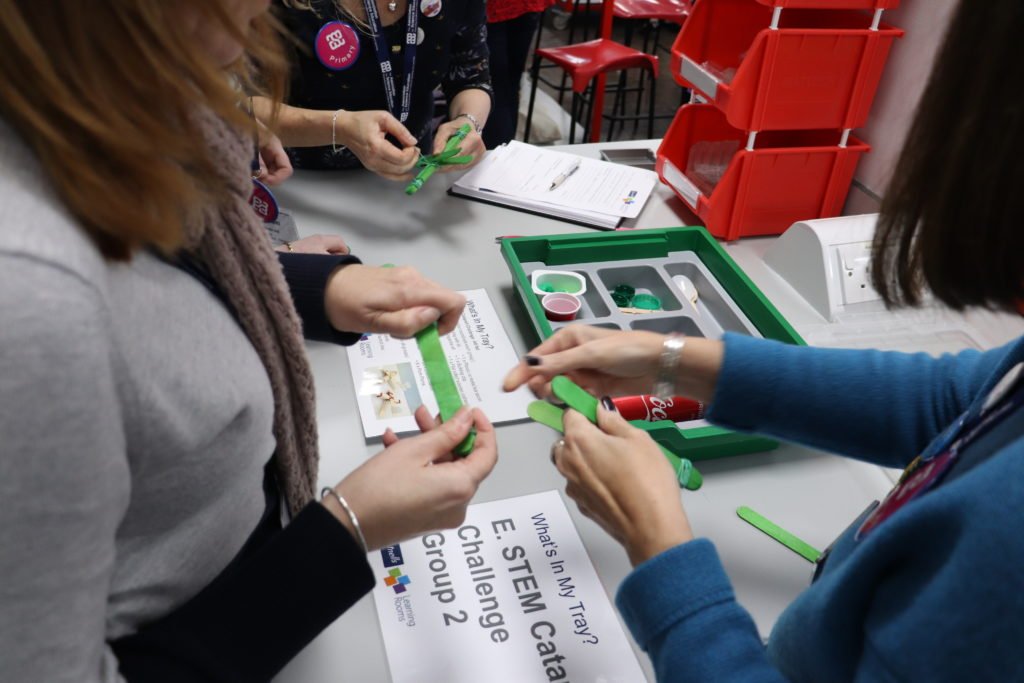
Use simple equipment or recycled materials to design and build your own catapult. Set distance and accuracy challenges, test and modify your model to get the best results.
Learning outcomes
You will be able to:
- Design and construct your own catapult
- Test and modify your design to achieve optimal results
- Critique and evaluate your own and other people’s designs
You will need (per group of 4):
- 1 x Shallow Gratnells (F1) tray with lid
- 1 x Office tray insert to organise all materials
- 20 x Craft stick
- 1 x Recycled cardboard tube
- 1 x Plastic shot glass
- 2-3 x Recycled plastic bottle top
- 1 x Teaspoon
- 1 x Bulldog clip
- 1 x Flat sided wooden clothes peg
- 1 x Blue Tack pack
- 1 x Yoghurt pot
- 20 x Rubber band
- 6 x Small pom pom
- 1 x Instruction sheet
For the firing range (can be used by all participants):
- 4 x Gratnells Art (A1) tray or 1 x Gratnells Art (A1) tray with target circles or bottle caps
- 4 x Bonus point cards
- 1 x Masking tape launch line
- 1 x Tape measure
Tip: If working with multiple groups, colour coordinate each group if possible. The equipment list provided details example construction items, however, suitable craft or clean recycled items from the home or classroom could also be used to make catapults, for example, bun cases, drinks cans, small plastic bottles etc. The entire catapult could also be constructed from Lego.
This activity also works for individuals or smaller teams, just increase the amount of time allocated to complete it. If multiple groups are competing simultaneously or in a carousel, you will need one set of equipment per group. The majority of the equipment can be reused afterwards for further STEM challenges.
Preparation:
- Print, cut out and laminate (optional) one set of the bonus points cards or make your own.
- Organise all the equipment into the office insert inside a shallow Gratnells (F1) tray and put the lid on.
- Print and laminate (optional) one copy of the activity instructions or view them on any device.
- Set up a safe test firing range to measure distance (masking tape launch line and a tape measure).
- Set up a safe target tray for accuracy (see example in picture or design your own) and decide on the points available.
What to do:
- Set a timer (optional) for building two catapults, how long is up to you and only necessary if carrying out this activity as a multiple group/participant competitive challenge.
- Approach the tray and lift the lid.
- Construct two different craft stick catapults using the equipment provided in the tray. You do not have to use all the equipment. See example catapult pictures for inspiration if needed.
- The winning catapult will be the one that shoots a pom-pom the furthest (distance challenge).
- Extra bonus points will also be available for hitting a target (accuracy challenge).
- Do not take your catapults apart when the buzzer goes. When all groups have completed the challenge, you will test your catapults and points will be awarded.
- Take a photograph to evidence your work.
Tidy up time:
- Put your completed catapults aside until you are ready to test them.
- Put any spare materials back into the tray, replace the lid.
- If multiple groups are completing the challenge in a carousel, put out a fresh tray of equipment for the next group.
- Leave the instructions on the table and the area tidy for the next group.
When all participants/teams have completed the activity, take it in turns to test fire your catapults. Capture photographs and video of your catapults in action. The catapult that shoots the pom-pom the furthest wins the distance challenge. Shoot three pom-poms at your target tray and allocate points accordingly, the catapult with the most points wins the accuracy challenge.
Example catapults:
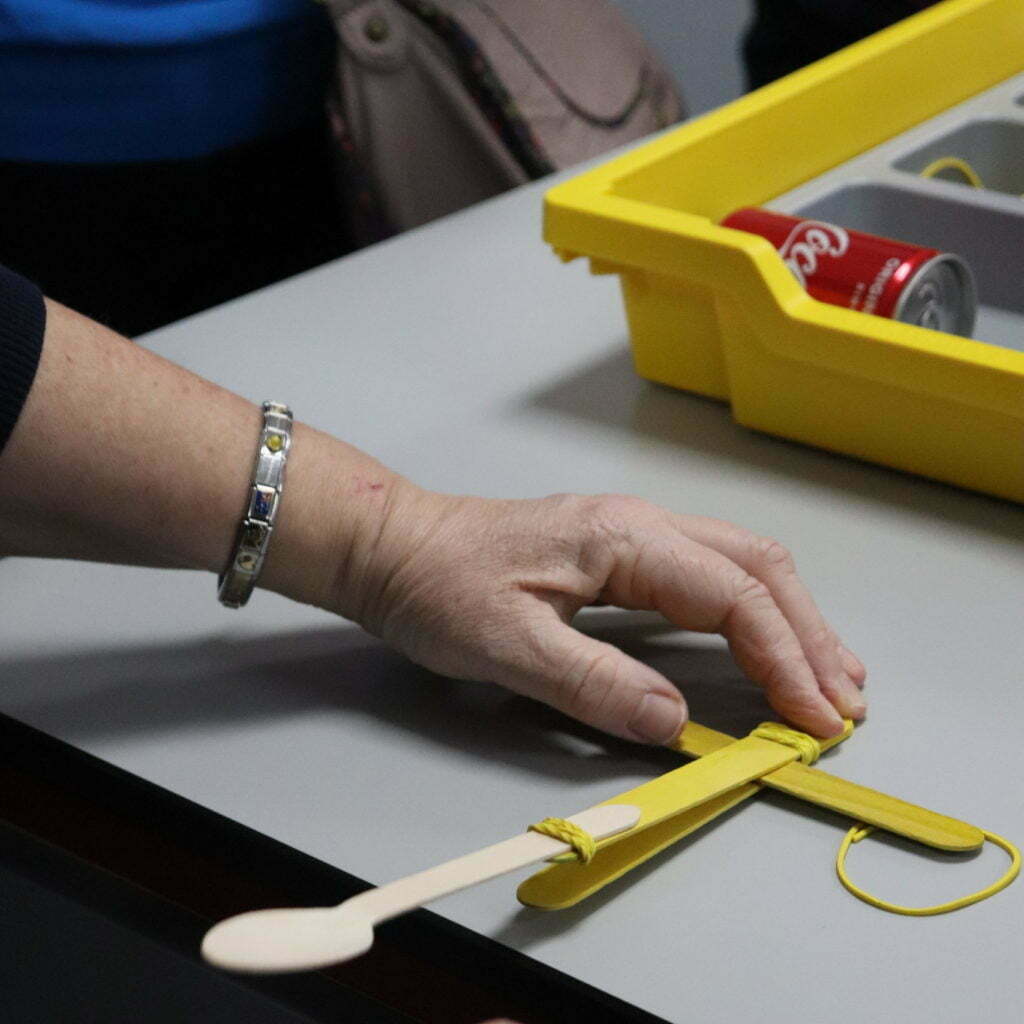
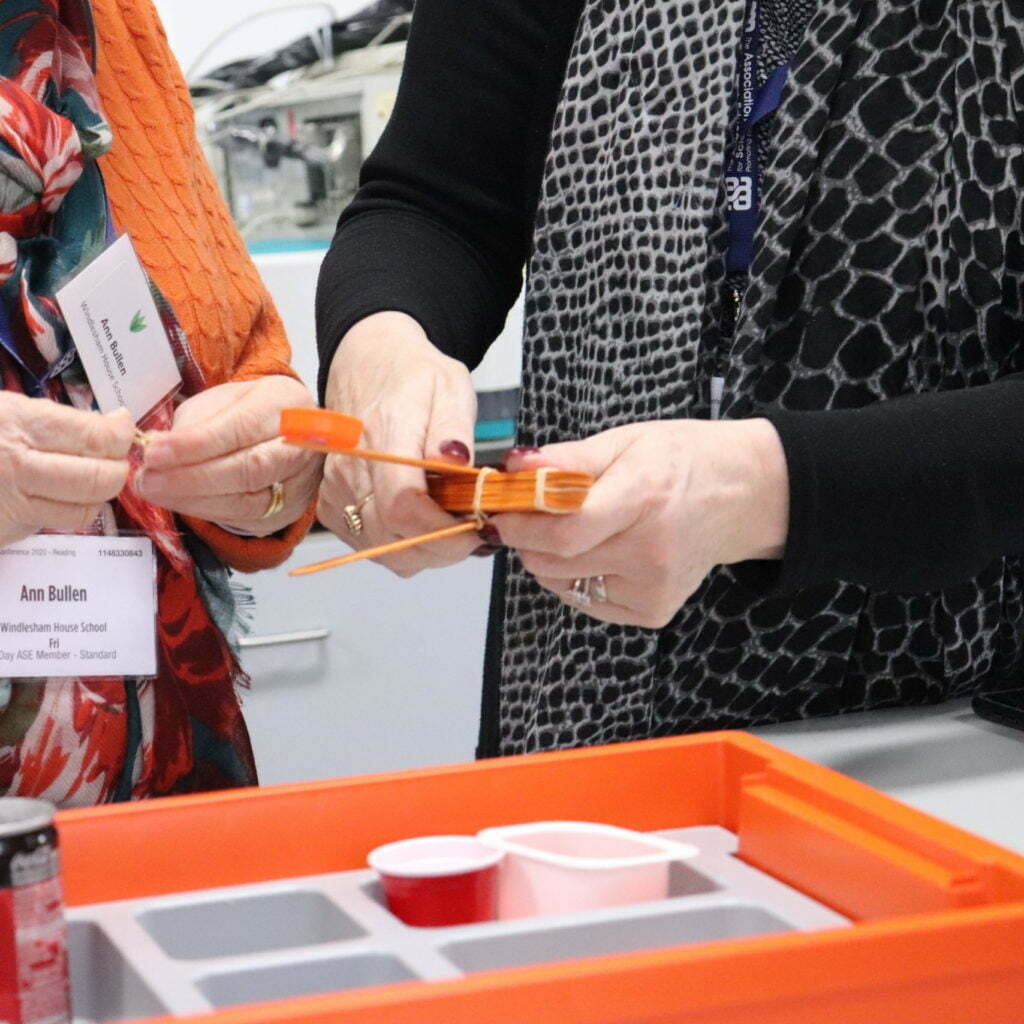
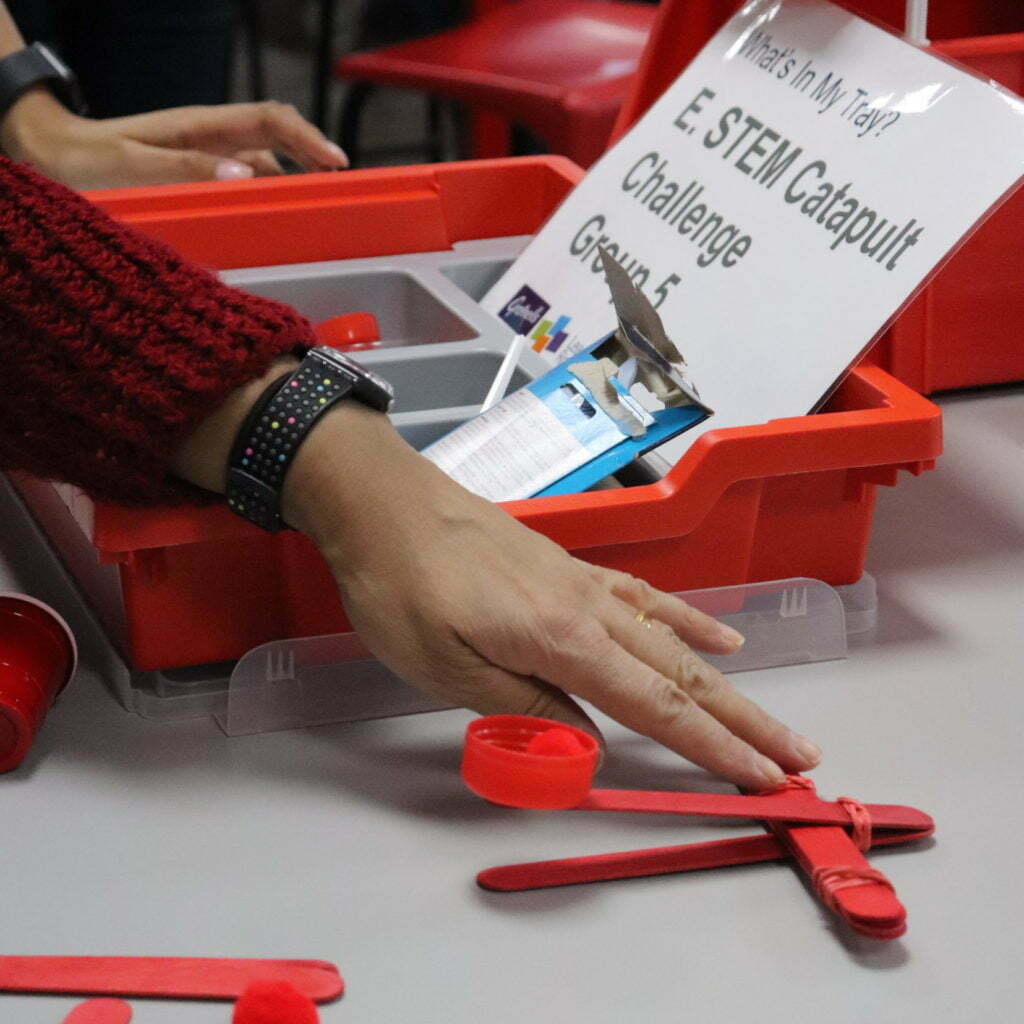
What is happening?
A catapult is a device used to launch a projectile, or in our activity, the projectile is a pom-pom. Catapults rely on the sudden release of stored potential energy to propel projectiles. Different designs generate this potential energy in different ways. The majority of our simple Lego® catapults pictured are of the ‘counterweight trebuchet’ design, our fingers provide the counter-weight or force. The craft stick and elastic band type designs are powered by the release of tension, or elastic energy. Elasticity is the tendency of solid materials to resume their original shape after deformation, rubber bands do this particularly well. Stretching, or deforming, your band generates potential energy. When released, the band quickly returns to its original shape, releasing potential energy that is used to propel the pom-pom through the air. Potential energy is converted into kinetic (movement) energy, the kinetic energy continues until it is overcome by the counteracting force of gravity and the projectile lands on the ground. The design of your catapult determines how much potential energy is generated, how efficiently this is released and the height and distance achieved by the projectile. Different catapults designs generate and release energy if different ways.
Catapults have been used as offensive and defensive weapons throughout history, many using spring mechanisms to generate large stores of potential energy capable of releasing heavy objects with huge and destructive force.
Other things to try…
- Which catapult design won the distance challenge? Which design won the accuracy challenge?
- Keep modifying and adapting your designs to achieve the best possible results.
- Look at other people’s designs or carry out research online and modify your design again. Have your modifications improved your catapult or not?
- Set a homework to research examples of where catapults have been used throughout history. How have their designs changed over time?
- Label pictures of different catapult designs to show the different types of energy involved.
- Can you recreate any of the designs using the materials listed and additional recycled or craft materials?
- Share photographs and videos of your catapults on social media using #WhatsInMyTray.
Health & Safety
As with all Gratnells Learning Rooms What’s in my tray? activities, you should carry out your own risk assessment prior to undertaking any of the activities or demonstrations. In particular, projectile and small object choking hazards should be considered.


